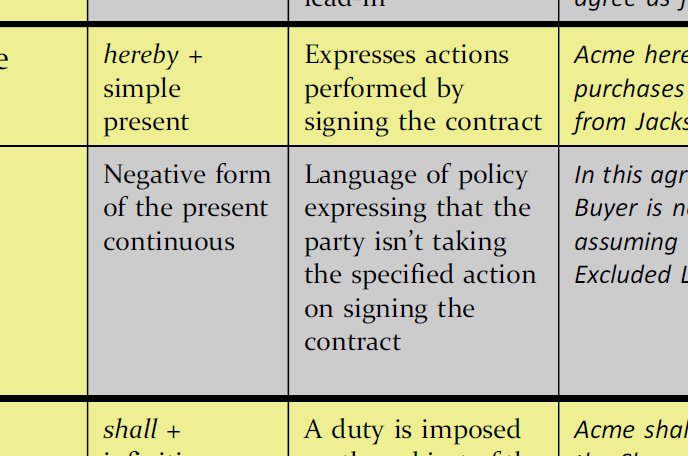
Yesterday, during session 3 of a private series of Drafting Clearer Contracts: Masterclass, we spent almost an hour considering, and coming up with alternatives to, suboptimal verb structures in a set of big-company standard terms.
A participant then suggested it wouldn’t be feasible to engage in that sort of surgery when reviewing the endless stream of counterparty draft contracts sent their way. That led to our discussing how, when it comes to revising contracts, what changes are appropriate depends on whether you’re drafting or reviewing. If you’re reviewing, you limit your changes to that which doesn’t reflect the deal as you understand it, and that which might cause confusion. You’re not trying to turn the other side’s draft into a thing of beauty.
More specifically, when it comes to verb structures, I suggest you primarily aim to avoid the following kinds of confusion:
- Confusion over whether a party is transferring something at signing or whether they have an obligation to transfer it at some future point—it can lead to fights. See this 2021 blog post for a court opinion addressing that issue. (The court cites MSCD.)
- Expressing something as an obligation although it makes sense to express it as a condition. For example, don’t say Acme shall send Widgetco a dispute notice no later than … . This too can lead to fights. Instead, say (as one option) To dispute an invoice, Acme must … .
- To express obligation, discretion, or prohibition, don’t use the passive voice, as you’ll be less direct than you could be and, more importantly, you might drop the actor, causing confusion. See this 2019 blog post for an example of a fight over this kind of confusion. Instead, use the active voice. For example, say Acme shall pay the Investment Amount … instead of The Investment Amount shall be paid … .
Generally, you’re safe ignoring other verb-structure glitches, such as saying New York law shall govern this agreement instead of New York law governs this agreement. No one’s going to get into a fight over that.
So you should aim to process each main verb structure in your mind as you read through the contract, moving on quickly if it doesn’t present significant issues. As I constantly remind anyone who takes my training, if a sentence contains a shall, the first thing you should do is subject that shall to the has a duty test. (See this 2020 blog post for an overview of the has a duty test; the definitive account is in the fifth edition of MSCD.) And for every verb structure, ask, What category of contract language should this be? When you figure that out, the “categories of contract language” framework will tell you what verb structure is appropriate. This sounds very involved, but once you get used to the patterns, much of the processing takes a fraction of a second. Sometimes, more thought is required; that’s usually a sign of potential confusion.
If you’ve not encountered my “categories of contract language” framework before, go here for the quick-reference chart that’s in MSCD.
(By the way, while we’re on the subject of reviewing the other side’s draft contracts, you might find of interest my article with co-author Michael Fleming, Reviewing Business Contracts: What to Look for and How to Look for It. It was one of the ACC Docket’s eleven most-read articles in 2022.)
